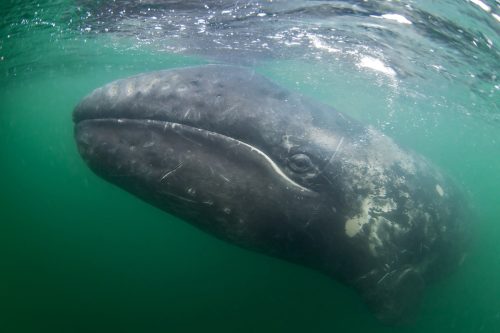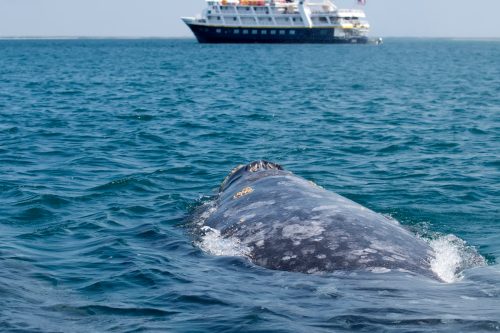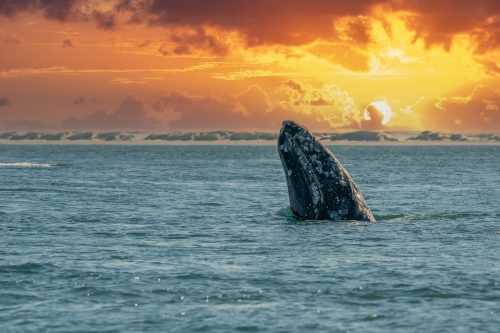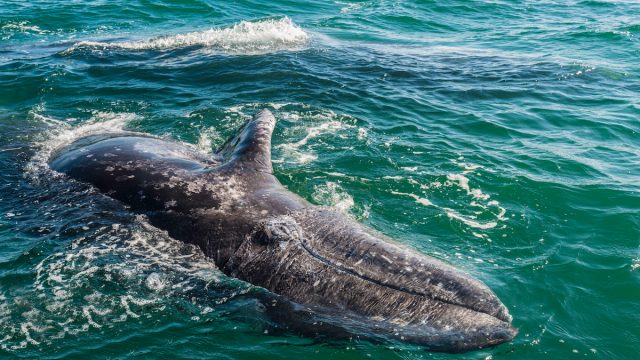Scientists Reveal the Heartbreaking Reason Dead Gray Whales Keep Washing Up on Shore
Since 2019, at least 688 gray whales have been found stranded and dead.
Successfully removed from the endangered species list in 1994, gray whales are once again in danger. According to the National Oceanic and Atmospheric Administration (NOAA), since 2019, 346 dead gray whales have been "stranded" on land along the Pacific Coast of the U.S.—and that number climbs to 688 when you include Canada's and Mexico's western shorelines. Since these whales can grow up to 49 feet in length and weigh up to 90,000 pounds, rescuing and rehabbing them is not an easy feat. Now, scientists have revealed the heartbreaking reason why gray whales keep washing up on shore. Keep reading to learn more about this issue and if it can be stopped.
RELATED: This Is How Many Polar Bears Are Left in the World.
Gray whales have long been threatened.

According to the NOAA, gray whales were once found throughout the oceans of the Northern Hemisphere, however commercial whaling eventually limited their population to the North Pacific Ocean.
"International conservation measures were enacted in the 1930s and 1940s to protect whales from over-exploitation, and in the mid-1980s the International Whaling Commission instituted a moratorium on commercial whaling," they explain.
As mentioned, in 1994, the eastern stock, or Distinct Population Segment (DPS)—those gray whales found in North America versus those in Asia that are still endangered—was delisted from the Endangered Species Act.
They continue to face threats during their annual migration.

"Gray whales make one of the longest annual migrations of any mammal, traveling about 10,000 miles round-trip and in some cases upwards of 14,000 miles," explains the NOAA. And while this long journey creates plenty of whale-watching opportunities, it also puts these beautiful animals in harm's way.
Collision with vessels is the largest avoidable threat to gray whales, says the NOAA. The animals feed and migrate along the West Coast, which has some of the highest vessel traffic in the world.
Many of these boats are commercial fishing vessels, which present additional threats in the form of whales becoming entangled in fishing gear.
"Once entangled, whales may drag and swim with attached gear for long distances or be anchored in place and unable to swim," explains the NOAA. "Events such as these result in fatigue, compromised feeding ability, or severe injury, which may ultimately lead to death."
But these threats do not account for recent strandings.
RELATED: Now Is Your Last Chance to See Pandas at U.S. Zoos—Here's Why.
Strandings have been rapidly increasing in recent years.

In 2019, after a series of whale strandings on the West Coast, the NOAA declared the pattern an Unusual Mortality Event (UME), which they define as "a stranding that is unexpected; involves a significant die-off of any marine mammal population; and demands immediate response."
By June of that year alone, at least 70 gray whales were found dead and stranded on the coasts of California, Oregon, Washington, and Alaska, Phys.org reported at the time. To put that in perspective, they noted that normally, an average of 35 gray whales were found dead on the West Coast each year.
"There have been juveniles but adults as well. There have been males and females. It's been all across the board at this point," Justin Viezbicke, NOAA's California Stranding Coordinator, told the outlet.
"Most whales, and especially emaciated whales, will tend to sink when dead," added John Calambokidis, a research biologist with the Cascadia Research Collective in Olympia, Washington. "So the numbers that wash up represent a fraction of the total. The vast majority go unreported."
RELATED: 40 Ocean Facts That Will Blow You Out of the Water.
Scientists now have evidence that climate change is to blame.

Since 2019, scientists have continued to witness gray whales washing up on shore in record numbers, simultaneously researching the root cause outside of vessel collisions. And now, researchers from Oregon State University believe that climate change is to blame, according to a study published this month in the journal Science.
"It feels like this time we've got a pretty good smoking gun," Josh Stewart, an assistant professor at Oregon State's Marine Mammal Institute and the lead author on the study, told news outlet KTVB. "We can now say much more conclusively that it is probably Arctic conditions that are driving these things."
As KTVB explains, gray whales begin their migration journey in Mexico, where they give birth. They then travel to the Arctic to feed for four months before beginning the trip anew. Their primary food source is small crustaceans called benthic amphipods, which feed on algae growing on the underside of sea ice. But with climate change warming the Arctic region, there is less sea ice, fewer algae, and, in turn, fewer benthic amphipods for whales to eat.
This is especially problematic since gray whales fast for the other eight months of the year; so, during their four months in the Arctic, they need to "gorge themselves," Stewart told NBC News.
"When you have less sea ice and fewer days of sea ice, you don't get that algae reaching the sea floor to create that productivity that the gray whales need," Stewart explained to KTVB. "We know that the resources that gray whales are relying on—to feed, to make a living, to reproduce—are already heavily impacted by climate change and will continue to be increasingly impacted by climate change."
But there is hope for the gray whale population.

Despite the harrowing effects of climate change, Stewart says he feels confident that gray whales will not go extinct: "They've lived through major climatic change in the past. They're quite adaptable," he told NBC News.
However, he did caution that gray whales are likely to survive in smaller numbers than in the past. "We're going to be increasingly living in a world where we're going to have to deal with these impacts that are hard to reverse and have really significant effects on species that we care a lot about," he told KTVB. "And that's a hard thing to stomach."
As NBC News reported, the North Pacific gray whale population was roughly 27,000 in 2016; today it has shrunk to 14,500.
- Source: https://www.fisheries.noaa.gov/national/marine-life-distress/2019-2023-gray-whale-unusual-mortality-event-along-west-coast-and
- Source: https://www.fisheries.noaa.gov/species/gray-whale
- Source: https://www.fisheries.noaa.gov/national/marine-mammal-protection/marine-mammal-unusual-mortality-events
- Source: https://www.science.org/doi/10.1126/science.adi1847






















